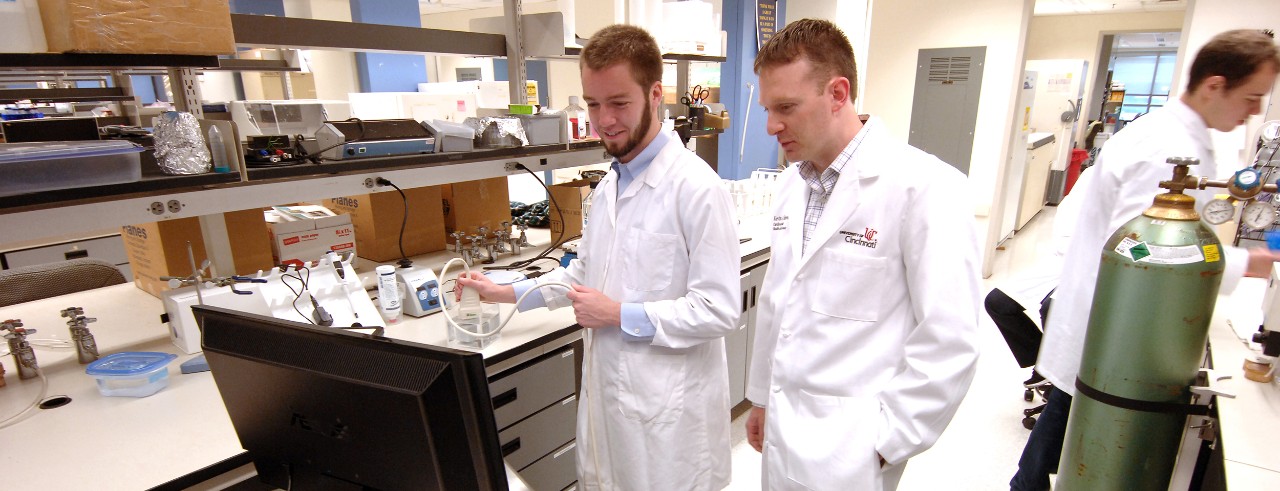
Ultrasound, microbubbles may hold the key to solving a paradox
UC scientist hopes new technique will someday aid heart attack patients
During a heart attack a coronary artery is suddenly blocked depriving the heart of oxygen and damaging this vital pump.
Medical professionals work feverishly to restore oxygen and save a life.
But it is during this process a paradox arises: If blood returns too quickly to a weakened heart, it can be further damaged, something known as “reperfusion injury,” explains Kevin Haworth, associate professor of cardiovascular health and disease, in the University of Cincinnati College of Medicine.
“The analogy I like to use is: put a kid in a candy store and offer free rein,” says Haworth. “The kid picks up and eats as much candy as they like, and they end up with a bellyache later on because they got too much of that good thing.
“In the case of the heart after a heart attack, there is too much oxygen during the initial stage of reperfusion,” said Haworth. “Oxygen gets converted too quickly, further damaging heart cells and that’s the origin of this injury. Since there is too much oxygen is there a way to initially reduce the amount?”
Haworth, who holds a doctorate in applied physics, thinks he has an answer to that question. If he’s right, it could be lifesaving to 150,000 people in the United States annually who die from a heart attack. He has developed a novel, ultrasound-based technique that allows measured isolation of oxygen from the blood to reduce reperfusion injury. His technique consists of a catheter-based system that would deliver and activate emulsion using ultrasound.
The technique will be tested further in animal models and Haworth’s work is being supported by a recent $3.6 million five-year grant from the National Institutes of Health. The project demonstrates UC's commitment to research as described in its strategic direction called Next Lives Here.

Lab assistant Rachel Benton, Assistant Professor Kevin Haworth and medical sciences student Abby Clark work in a UC College of Medicine laboratory. Photo by Joe Fuqua/UC Creative + Brand
Haworth, also a researcher in the UC Heart, Lung and Vascular Institute, says the technique relies on a process known as “acoustic droplet vaporization,” where a liquid droplet is converted into a gas microbubble when exposed to ultrasound.
“We use droplets about the size of red blood cells or smaller,” says Haworth. “We hit them with ultrasound and they convert from little liquid droplets into little gas bubbles. It turns out these gas bubbles are really good at sucking up all the oxygen in the environment around them.”
A partial reduction in oxygen as blood returns to damaged heart tissues can reduce the amount of reactive oxygen species — unstable molecules which interact with cells causing damage in tissue — during reperfusion, says Haworth.
“The reperfusion injury occurs, in part, due to the ischemic tissue converting the newfound supply of oxygen into reactive oxygen species, which can significantly damage a cell and lead to cell death, says Haworth. “Studies in cell culture and rat hearts have shown that reducing the oxygen partial pressure reduces the amount of reactive oxygen species.”
NIH grant 1R01HL148451-01 supports this research.
Collaborators in this study include Dr. Andrew Redington, a UC professor of pediatrics and chief of pediatric cardiology at Cincinnati Children’s Hospital; Christy Holland, UC professor of medicine and biomedical engineering; and John Lorenz, UC professor of pharmacology and systems physiology.
Featured image at the top: UC student Nathan Perry is shown with Kevin Haworth, PhD, in a UC College of Medicine lab. Photo by University of Cincinnati
Next Lives Here
The University of Cincinnati is classified as a Research 1 institution by the Carnegie Commission and is ranked in the National Science Foundation's Top-35 public research universities. UC's graduate students and faculty investigate problems and innovate solutions with real-world impact. Next Lives Here.
Related Stories
Small business predictions for 2026
January 8, 2026
In 2026, small business leaders will likely adapt to AI and cybersecurity threats as they consider new funding sources, training strategies and realities in today’s business environment.
World class: Alumni travel program connects Bearcats on global scale
January 7, 2026
Most people have a natural curiosity to see the world. Meanwhile, most Bearcats enjoy being around other Bearcats. Alumni can check both boxes through the UC Alumni Association’s travel program, which offers about half a dozen excursions each year to fascinating places around the globe.
UC launches Bearcat Affordability Grant
January 7, 2026
The University of Cincinnati is making college more attainable for students across Ohio with the creation of the Bearcat Affordability Grant. The new grant will provide a pathway to tuition-free college for students of families who make less than $75,000 per year. Beginning in fall 2026, the Bearcat Affordability Grant will cover the remaining cost of tuition for Ohio residents who are Pell eligible.
